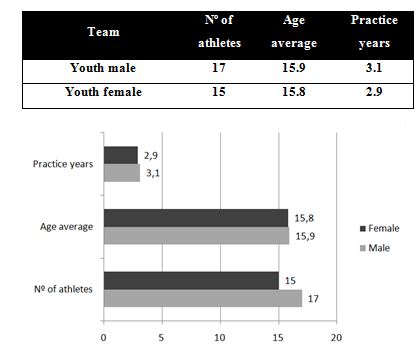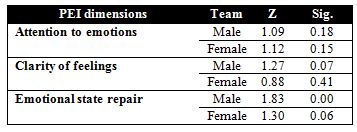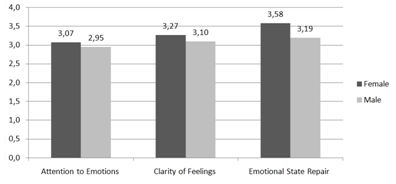
|
|||
|---|---|---|---|
|
|
Sport and emotional requirements: comparative study of perceived emotional intelligence among young men and women’s basketball players
Deporte y exigencias emocionales: estudio comparativo de la inteligencia emocional |
|
|
|
Research Center in Sports Sciences, Health Sciences and Human Development (CIDESD) – UTADUTC Sports and Expressions - ESECD Polytechnic Institute of Guarda Research Unit for Inland Development (UDI) – Guarda |
Teresa Fonseca (Portugal) |
|
|
|
Abstract The physical capabilities and tactics of basketball players are, currently, very similar, and besides their psychological skills, also their emotional state is crucial to the respective sport performance. Indeed, the sport practice of basketball players directly related to their emotional state and in the heat of competition can favor both the players or hurt them, since they may prescribe the expertise of their sports practices. In this context, we carried out a study with a sample of 32 young female and male basketball players, with the aim of studying the perceived emotional intelligence (PEI) in their three dimensions (attention to emotions, clarity of feelings and repair of emotional state) . The PEI was assessed with the Trait Meta-Mood Scale (TMMS-24; Salovey et al., 1995). The results indicated differences statistically significant in women's team in all aspects of the PEI, but not in men's team. Keywords: Emotional intelligence perceived. Young basketball players. Emotional control. Sports performance.
|
|||
|
|
EFDeportes.com, Revista Digital. Buenos Aires, Año 16, Nº 163, Diciembre de 2011. http://www.efdeportes.com/ |
|
|
1 / 1
Introduction
The increasing standardization of methodologies and training techniques for improving the preparation of athletes could lead us to believe in the feasibility of a uniform level of athletic performance. However, we continue to see the significant differences at this level. Currently, in basketball, it is not enough to be tactically and technically clever; the basketball players should also be it in emotional terms. The growing interest in this area arises from the assumption that psychological skills are not necessarily innate and, as such, liable to specific training for athletes as part of any other capabilities.
To develop their self-control ability, for an athlete it is very important control their impulsiveness, their emotions and their conduct in general, particularly in the most adverse circumstances when it is more difficult to establish emotional control (Pussy, 2004). In the heat of the competition, the athlete’s emotions will favor them or hurt them, as they can prescribe the expertise of their sports performances and can contribute to arousal, alertness, and elation or frustration, anger and apathy, that is, can potentiate or inhibit the sport performance.
The emotions usually appear as the answer to a situation, whether internal or external to the individual, and that will have for him a positive or negative valence (Salovey & Mayer 1990, Mayer et al., 2000).The experience and interpretation of certain emotions and their regulation can cause problems performance (Lam & Kirby, 2002), but not always negative emotions are harmful (Staw et al., 1994). As Mahoney & Myers (1989) refer, evaluation and the ability of athletes to deal with their emotions play a role in their performance. When individual perception is emotionally superior, they are usually more creative, leading to greater flexibility in the use of attention and memory as well as to create more alternatives (Salovey & Mayer, 1990).
Some authors, such as Mayer and Salovey (1990) and Mayer and Salovey (1993) argue that emotional balance produces a range of thoughts and it allows you to create future plans. Positive emotions improve memory and thus the cognitions are integrated in a more positive way, allowing process and focus in a greater number of individual needs, can be used to motivate and support difficult intellectual tasks. The positive state of mind also serves to motivate for the persistence of change in tasks (Salovey & Mayer, 1990).In general, emotional intelligence describes the ability to evaluate and express emotions and use them for motivational purposes and for decision making (Mayer & Salovey, 1990). Whereas for some, emotional intelligence is constituted by skills specific of emotions, such as perception, recognition, understanding and managing emotions (Mayer & Salovey, 1995), others suggest that this concept is broader and includes skills for an effective interaction, such as empathy, time management, decision making and team work (Bar-On, 2001; Cooper & Sawaf, 1997). For Goleman (1995, p.54) emotional intelligence is “the ability of a self-motivation of a subject and persistence, in spite of frustrations, to control the impulses and delay gratification, to regulate their own state of mind and prevent that discouragement subdue the ability to think, to empathize empathy and to have hope”. PEI refers to the intrapersonal skills and can be defined as an individual's ability to understand, clarify and regulate emotions (Queiroz et al., 2005). We can then say that the PEI refers to the meta-knowledge that people have over their intellectual abilities (Salovey et al., 1995), which correspond to the capabilities of attention, clarity and intrapersonal emotional repair (Fernandez-Berrocal et al., 2001).
According to Queiroz et al. (2005), these capabilities can be defined as follows:
-
Attention to emotions – it refers to the degree to which people believe paying attention to their feelings.
-
Clarity of feelings - refers to how people perceive and believe understand their emotions.
-
Emotional state repair - the ability that the subject has to believe in their ability to interrupt negative emotional states and prolong positive ones.
There are some tools that allow us to measure intrapersonal emotional intelligence, but one that has been mostly used as a measure of self-reporting has been the Trait Meta-Mood Scale (TMMS) that evaluates the perceived emotional intelligence, i.e., the meta-knowledge that people have about their emotional skills (Queiroz, 2004).
Knowing that our understanding of the emotional processes and their relationship to performance is in embryonic stage and that sometimes these processes appear to act as drivers of performance over others that appear to inhibit athletic performance of athletes, the main goal of this study was to assess the dimensions and check whether there are differences between male and female handball players in the three dimensions (attention to emotions, clarity of feelings and emotional state of repair). In this context, the following study hypothesis was formulated: there are statistical significant differences between male and female youth team basketball in the three dimensions of PEI.
Methodology
Our sample was composed of athletes (n=32) of two youth male and female handball teams, both of Portuguese nationality and who were competing for national championships. The basketball players have between 15 and 17 years old and their practice years are between 2 and 6 years. The men's team was composed of 17 elements with an age average of 15.9 years old and an average of 3.1 of practice years. The women's team was composed of 15 elements with an age average of 15.8 years old and an average of 2.9 of practice years. The goals of both teams were the level maintenance at which they were competing.

Figure 1. Comparison of average values of age and years of sports between the two teams
To achieve this study we used the Trait Meta-Mood Scale (TMMS-24), version developed by Fernández-Barrocal et al. (2004), later adapted and validated to Portuguese by Queiroz, et al. (2005). This scale is a measure of self-report, built to access the belief that each individual has on their own emotional abilities. This instrument assesses how individuals deal with their emotions and emotional states make a clear distinction between them and regulate them. The Portuguese version of TMMS - 24 consists of 24 items, 8 for each dimension, assessed on a Likert scale of 5 points (from 1 = strongly disagree to 5 = strongly agree). The higher the average value, the better the performance of individuals in each dimension.
This instrument was applied to the athletes, before the training session and they were informed in advance about how to complete and to the general features of the work. The coaches of both teams were personally contacted about the study objectives.
The data were processed using version 11 of SPSS for Windows. In addition to descriptive statistics (mean and standard deviation) the sample normality was checked with the Kolmorov-Smirnov test that allows us to conclude about the normal distribution in all dimensions of the questionnaire. In addition, we also used the t-test and one-way Anova for statistical inferences. In either case the level of significance was p <0.05.
Results
Taking into account the objective and hypothesis of the study and the formation of the sample, we present the results based on the main objective of this research. Table 1 shows the values obtained with the normality test.
Table 1. Test of normality applied to both teams

According to Table 1, we applied the t-test (attention to emotions, clarity of feelings and emotional state repair) whose values (p) are presented in Table 2, which lets us check the averages in each dimension the size of the PEI and determine the existence or not of differences statistically significant.
Table 2. The difference between male and female teams in PEI dimensions


Figure 2. Graphical analysis of the differences between male and female team in the PEI dimensions
When comparing the average values in both teams, as shown in Table 2 and Figure 2, it was possible to verify the existence of statistically significant results in all dimensions, including attention to the emotions (p=0.00), clarity of feelings (p=0.02) and emotional state repair (p=0.02) for the significance level of p <0.05, showing the female team the higher average values. It is also evident that the female team had the average values in all dimensions great than the correspondent male team values. It was also possible to see that the highest average value (3.58±0.48) in women's team was in the emotional state repair dimension and the lowest (3.07±0.32) was found in the clarity of feelings dimension. In the men's team similarly to the women's team, the highest value (3.19±0.63) was in the emotional state of repair dimension and the lowest (2.91±0.32) was in the clarity of feelings dimension. We also observed that in both cases the standard deviation was below 1, showing thus that the average values were not widely dispersed.
The obtained results are similar to the obtained by Fernandez-Berrocal et al. (1998, cit. Extreme by Pacheco and Fernandez-Berrocal, 2005) and Berrocal, Alcaide and Ramos (1999, cit. Extreme by Pacheco and Fernandez-Berrocal, 2005) in a study of teenagers, in which individuals of the female gender had higher levels in the attention to the emotions dimension in relation to males. These, in turn, obtained higher values in other dimensions (clarity and emotional repair), a fact which was not observed in our study. They also seem to corroborate the results obtained by Peixoto (2003) which showed a variability of emotional competencies regardless of gender with the female’s positive correlations in the following dimensions: personal assessment of emotions and use of emotion and emotion regulation. According to the same author, the gender difference is not due to different ratios of emotional intelligence, but rather to the fact that female gender points to better results in skills such as empathy, interpersonal relationships and social responsibility, while the males performed better results in the auto update, stress tolerance and adaptability. However, Mourão (2002) states that the higher values shown by the female gender is not due to gender differences but to the power of observation and perception of reality, because the more attention is devoted to events that occur, the greater the emotional sensitivity. Thus there are individuals who feel more emotion than others.
Conclusions
The obtained results allowed us to conclude there are statistical significant differences in how the basketball players feel and express their feelings, as they understand the emotional states and how to regulate them. Thus, correlations were found in the women's team in all aspects of PEI. The study hypothesis was confirmed, as statistically significant differences were found in all dimensions, with the women's team obtained values higher than the average male.
We understand that the mental state of a basketball player establishes a strong relationship with its sport performance, so the sport is unthinkable without emotions. And being self conscious goes through the perception of these emotions and the capacity of using them in favor of its benefits and others (Mourão, 2002). According to Totterdell and Leach (2001), also the emotional control is associated with emotional states and player’s performance, assuming that individuals can effectively manage their emotions there will be able to use these emotional experiences during the competition, thus having a better performance. Thus, it would be desirable to work closely with technicians and sport psychologists in order to enhance the emotional intelligence of basketball players as to raise their sport performance.
References
-
Bar-on, R. (2001). Emotional intelligence and self-actualization. In J. Ciarrochi, J.P. Forgas & J.D. Mayer (Eds.): Emotional intelligence in everyday life: a scientific inquiry, pp. 82-97. New York: Psychology Press.
-
Buceta, J. (2004). Estrategia psicológica para entrenadores de deportistas jóvenes. Madrid: Dikynson.
-
Cooper, R. & Sawaf, A. (1997). Inteligência Emocional na Empresa. Rio de Janeiro: Campus.
-
Extremera Pacheco, N. e Fernandez-Berrocal, P. (2005). Inteligência emocional percebida y diferencias individuales en el meta-conocimiento de los estados emocionales: una révision de los estúdios com el TMMS. Málaga: Universidade de Málaga.
-
Fernandéz-Berrocal, P. Ramos Diaz, N. e Extremera Pacheco, N. (2001). Inteligencia emocional, supresión crónica de pensamentos y ajuste psicológico. In Boletín de Psicología, nº 70, pp. 79-95. [On Line]. Disponível em: http://campusvirtual.uma.es/intemo7pdfs/boletin.pdf
-
Goleman, D. (1995). Inteligência Emocional. Editora idea y creación, S. I. Suplemento da revista Sábado.
-
Lam, L. e Kirby, S. (2002). Does emotional intelligence give you na edge? An exploration of the impacto of EQ and IQ on individual performance. The Journal of Social Psychology, 142 (1), pp. 133-143.
-
Mahoney, M. e Myers, A. (1989). Anxiety and athletic performance: traditional and cognitive developmental perspectives. In D. Hackfort, C. D. Spielberger (Eds.): Anxiety in sports: An international perspective, pp. 77-94. New York: Hemisphere.
-
Mayer, J. e Salovey, P. (1995). Emotional intelligence and construction and regulation of feelings. Applied Preventive Psychology, 4, pp. 197-208.
-
Mayer, J. e Salovey, P. (1993). The intelligence of emotional intelligence. Intelligence, 17, pp. 433 - 442.
-
Mayer, J. Salovey, P. e Caruso, D. (2000). Emotional intelligence as zeitgeist, as personality and a mental hability. In R. Bar-On & J. D. A. Parker (Eds.): The handbook of emotional intelligence. Theory, development, assessment and application at home, school and the workplace, pp. 92-117. San Francisco: Jossey-Bass.
-
Mourão, R. (2002). Inteligência emocional: passos para uma vida plena nos anos dourados. [On Line]. Disponível em: http://www.institutokoziner.com/pdf/rutealmeida.pdf.
-
Peixoto, B. (2003). Inteligência emocional e desempenho em centros de fitness. Um estudo exploratório. Dissertação de mestrado apresentada à Faculdade de Desporto da Universidade do Porto.
-
Queirós, M., Cancela Carral, J. e Fernández Berrocal, P. (2004). Inteligência Emocional Percebida (IEP) e Actividade Física na Terceira Idade. Revista de Psicologia, Educação e Cultura, Vol. III, nº1, pp.187-208. Colégio Internato dos Carvalhos.
-
Queirós, M., Fernández Berrocal, P., Extremera, N., Cancela Carral, J. e Queirós, P. (2005). Validação e fiabilidade da Versão portuguesa Modificada da Trait Meta-Mood Scale. Revista de Psicologia, Educação e Cultura, Vol. IX, nº1, pp. 199-218. Colégio Internato dos carvalhos.
-
Staw, B., Sutton, R. e Pelled, l. (1994). Employee positive emotion and favorable outcomes at the workplace. Organization Science, 5, pp. 51-71.
-
Salovey, P., & Mayer, J. (1990). Emotional intelligence. Imagination, cognition and personality, 9, pp.185-211
-
Salovey, P., Mayer, J., Goldman, S. e Palfait, T. (1995). Emotional Attention, Clarity and repair: Exploring emotional inteligence using the Trait Meta-Mood Scale: In J. W. Pennebaker (Ed.): Emotion, disclosure and health, pp. 123-154. New York: Bantam Books.
-
Totterdell, P. e Leach, D. (2001). Negative mood regulation expectancies and sports performance. An investigation involving professional cricketers. Psychology of Sport and Exercise, 2. pp. 249-265.
Another articles in English
 |

Búsqueda personalizada
|
|---|---|
|
EFDeportes.com, Revista
Digital · Año 16 · N° 163 | Buenos Aires,
Diciembre de 2011 |
|